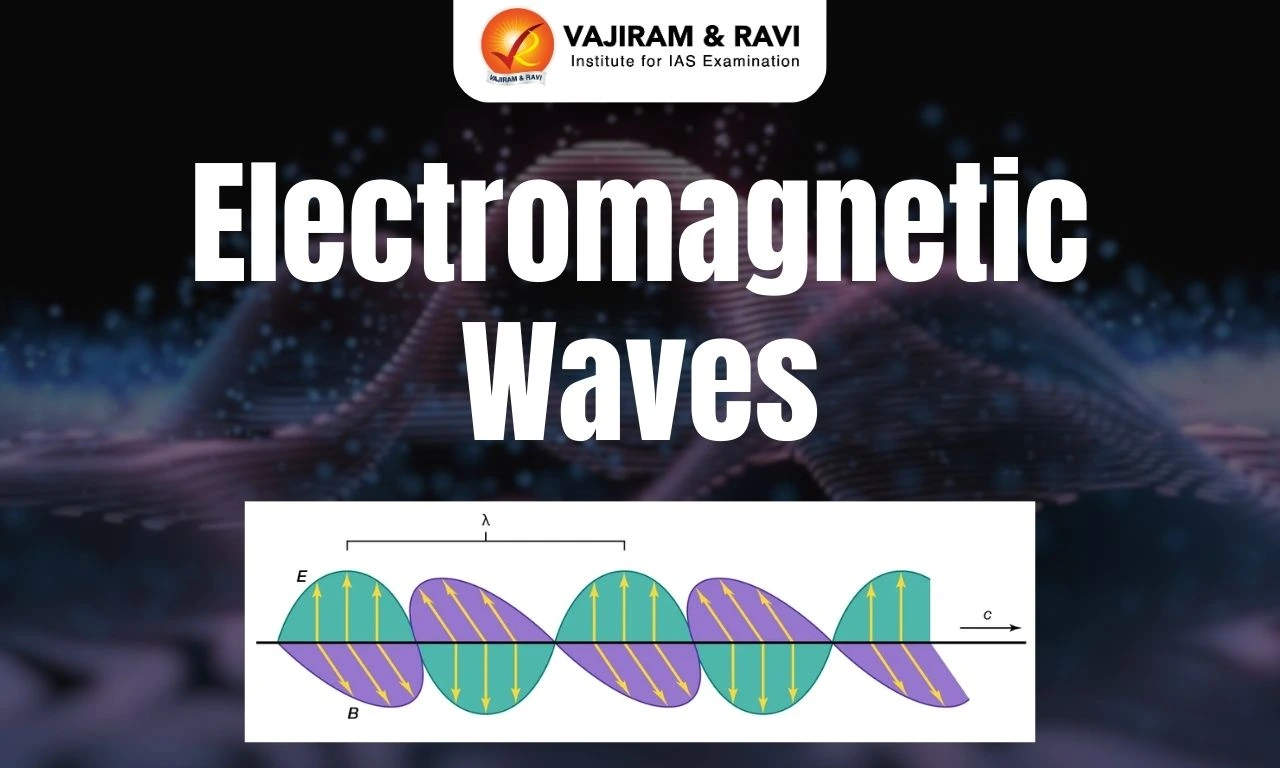Electromagnetic waves such as light are generated by the vibration (energy transformation) of electrically charged particles. These waves are characterised by their oscillating electric and magnetic fields, which move perpendicular to each other and the direction of wave propagation. Discovered by James Clerk Maxwell and verified later by Heinrich Hertz, these waves propagate at the speed of light, carrying energy and information across a wide spectrum of wavelengths from radio waves to gamma rays.
Electromagnetic waves are unique as they can travel through a vacuum, unlike sound waves. They play a vital role in natural phenomena as well as in numerous technologies.
Characteristics of Electromagnetic Waves
Electromagnetic waves exhibit several key characteristics that define their behaviour and interactions:
- Transverse waves: They are transverse, meaning their oscillations of electric and magnetic fields are perpendicular to the direction of wave propagation.
- Wavelength and frequency: Each wave has a specific wavelength (distance between successive peaks) and frequency (number of oscillations per second), which are inversely related.
- Speed: In a vacuum, all electromagnetic waves travel at the same speed, approximately equal to the speed of light.
- Energy: The energy of an electromagnetic wave is directly proportional to its frequency. Higher frequency waves like X-rays and gamma rays carry more energy than lower frequency waves like radio waves.
- No medium required: Unlike mechanical waves, electromagnetic waves do not require a medium to travel and can propagate through the vacuum of space.
- Spectrum: The electromagnetic spectrum encompasses a wide range of wavelengths and frequencies, from very long radio waves to very short gamma rays.
- Reflection, Refraction, and Diffraction: Electromagnetic waves can be reflected, refracted (bent), and diffracted (spread out), similar to waves in water.
- Polarisation: These waves can be polarised, meaning the orientation of their electric field can be aligned in a particular direction.
- Interaction with matter: Electromagnetic waves can interact with matter in various ways, including absorption, transmission, and scattering, depending on the nature of the material and the wavelength of the wave.
- Duality: Electromagnetic radiation exhibits both wave-like and particle-like properties (wave-particle duality), behaving as photons in certain situations.
Electromagnetic Spectrum
The electromagnetic spectrum is a continuum of all electromagnetic waves arranged according to frequency or wavelength. It is fundamental to understanding how energy is transmitted across space. The spectrum is a crucial tool in various scientific fields, aiding in the study of atomic and molecular structures, astronomical phenomena, and various forms of communication and imaging technology.

- Types: These waves vary greatly in their properties and are categorised into different types:
- Radio Waves
- Microwaves
- Infrared Waves
- Visible Light
- Ultraviolet Lights
- X-Rays
- Gamma Rays
Radio Waves
Radio waves are generated by charged particles undergoing acceleration, such as electrons in an antenna. When these particles accelerate, they create oscillating electric and magnetic fields, which propagate outward at the speed of light.
Features
- Long wavelengths: Radio waves have the longest wavelengths in the electromagnetic spectrum, ranging from about 1 millimetre to 100 kilometres.
- Low frequency: Their frequencies are the lowest among electromagnetic waves, spanning from about 3 kHz to 300 GHz.
- Non-ionizing: They are non-ionizing, meaning they don't carry enough energy to ionise atoms or molecules, making them safer for long-term exposure.
- Penetration ability: Radio waves can penetrate through various materials, making them ideal for communication.
- Propagation: They can travel long distances and propagate through the atmosphere,reflecting off the ionosphere for extended reach.
Applications
- Broadcasting: Used in radio and television broadcasting, transmitting audio and video signals over vast distances.
- Communication: Essential in mobile phones, wireless networks, and satellite communications. Near-field communication, Radio frequency identification devices (RFID) (Used in FasTag).
- Radar: Radio waves are used in radar systems for navigation, air traffic control, weather forecasting, and military applications.
- Altimeters: Altimeters are instruments used to measure altitude, the height of an object or point in relation to sea level or ground level.
- They are essential in various fields, particularly in aviation, where they help pilots determine their aircraft's altitude, ensuring safe flight operations.
- Navigation Systems: Used in GPS (Global Positioning System) for determining precise locations.
- Medical Applications: Certain radio frequencies are used in Magnetic Resonance Imaging (MRI) for detailed internal body imaging.
- Remote Control: Employed in remote-controlled devices, from toys to sophisticated drones.
Microwaves
Microwaves are generated using electronic devices called magnetrons. They are absorbed by materials containing polar molecules, especially water. When absorbed, the energy of the microwaves causes the polar molecules to vibrate,producing thermal energy (heat). Cosmic microwave background radiation fills the entire universe and is a clue to the Big Bang.
Features
- Wavelength and frequency: They typically have wavelengths ranging from one meter to one millimetre, corresponding to frequencies between 300 MHz (0.3 GHz) and 300 GHz.
- Penetration ability: Microwaves can penetrate clouds, glass, plastic, and similar materials, but are reflected by metal and absorbed by water.
- Non-Ionising radiation: Microwaves are non-ionizing, meaningthey don’t have enough energy to remove tightly bound electrons or cause cellular damage directly through ionisation.
- Directional propagation: Microwaves can be focused on narrow beams, making them suitable for point-to-point communication.
Applications
- Microwave ovens: Used for cooking and heating food bycausing water molecules in the food to vibrate, producing heat.
- Communication: Vital in telecommunications, including mobile phones, satellite communications, and Wi-Fi, due to their ability to carry large amounts of data over long distances.
- Radar systems: Used in radar technology for navigation, air traffic control, weather forecasting, and speed limit enforcement.
- Medical applications: Employed in certain medical treatments, such as diathermy, where microwaves are used to produce deep heating in body tissues for therapeutic purposes.
- Industrial processing: Used in various industrial processes, including drying materials, curing products, and chemical synthesis.
- Wireless networking: Essential in wireless data transmission technologies, including Bluetooth and Wi-Fi.
- GPS technology: Used in Global Positioning System (GPS) devices for navigation and location tracking.
- Remote sensing: Utilised in remote sensing applications for environmental monitoring, earth observation, and meteorology.
- Scientific research: Used in spectroscopy for studying the properties of molecules.
Infrared Waves
Infrared waves are invisible to the human eye but can be felt as heat. All objects emit infrared radiation as a function of their temperature. The hotter an object is, the more infrared radiation it emits.
Features
- Wavelength range: Infrared waves have wavelengths longer than visible light but shorter than microwaves, typically ranging from 700 nanometers (nm) to 1 millimetre (mm).
- Different bands: Infrared radiation is categorised into near-infrared (NIR), mid-infrared (MIR), and far-infrared (FIR), each with unique properties.
- Absorption and emission: Infrared waves are absorbed and emitted by molecules, particularly those in gases, which vibrate upon absorbing infrared energy.
- Non-ionising: They are non-ionising radiation.
Applications
- Thermal imaging: Infrared cameras detect heat emitted by objects and are used in night vision equipment, building inspections, and medical diagnostics.
- Remote controls: Commonly used in remote controls for TVs and other electronic devices.
- LiDAR: It is a remote sensing technology used to measure distances and create precise, three-dimensional information about the shape and surface characteristics of an area.
- Security and surveillance: Used in security systems for motion detection and surveillance, especially in low-light conditions.
- Environmental monitoring: Infrared sensing is used for monitoring vegetation health, water bodies, and environmental changes.
- Telecommunications: Some fibre optic cables use infrared light for transmitting data over long distances.
- Astronomy: It is used to study the relatively cooler objects across the universe (planets, cool stars, nebulae), hence useful to study the birth of these objects.
- It is also being used by the James Space Webb Telescope to study the origins of the universe.
- Industrial processes: Infrared sensors are used in manufacturing to monitor heat processes and product quality.
Visible Light
The visible spectrum encompasses all the colours perceivable by the human eye, from violet (shortest wavelength) to red (longest wavelength). The colours include violet, indigo, blue, green, yellow, orange, and red. exhibits both wave-like and particle-like properties. It behaves as a wave in phenomena like interference and as particles (photons) in photoelectric effects.
Features
- Wavelength range: Visible light spans wavelengths from approximately 380 nanometers (nm) to 750 nm, situated between ultraviolet and infrared radiation in the electromagnetic spectrum.
- Refraction and reflection: Visible light can be refracted (bent) and reflected, principles that are crucial in optics.
- Dispersion: When refracted, visible light can disperse into its constituent colours, as seen in a rainbow.
- Speed: In a vacuum, visible light travels at about 299,792 kilometres per second, the speed of light.
Applications
- Optics: Visible light is fundamental in optics, used in everything from eyeglasses and cameras to microscopes and telescopes.
- Colour science: Understanding how light interacts with materials is crucial in painting, printing, and digital display technologies.
- Photography and film: Capturing images using visible light is the essence of photography and cinematography.
- Communication: Fiber optic cables use light for transmitting data over long distances at high speeds.
- Solar Energy: Solar panels convert visible light into electrical energy.
- Medical and biological applications: Light is used in various medical diagnostics and treatments, including vision correction and phototherapy.
Ultraviolet Lights
Ultraviolet (UV) light is electromagnetic radiation that lies beyond the visible spectrum at its violet end. UV radiation influences atmospheric chemistry, particularly in the formation and depletion of ozone.
Features
- Wavelength range: UV light has wavelengths ranging from about 10 nanometers (nm) to 400 nm, shorter than visible light but longer than X-rays.
- Categories: It's divided into three main categories based on wavelength:
- UVA (315-400 nm): Known as "long wave" UV, it penetrates deep into the skin.
- UVB (280-315 nm): Medium-wave UV, responsible for sunburn and direct DNA damage.
- UVC (100-280 nm): Short-wave UV, most harmful but mostly absorbed by the Earth's atmosphere.
- Energy levels: UV light is more energetic than visible light, with UVC being the most energetic.
- Invisibility: UV radiation is not visible to the human eye.
Applications
- Medical and health: Used in sterilisation and disinfection, phototherapy for skin conditions, and dental procedures.
- Water purification: UV light can kill bacteria and viruses in water, making it a popular method for water disinfection.
- Forensics and security: Used to detect and analyse substances invisible to the naked eye, such as fingerprints and certain inks.
- Industry: In the curing of inks, coatings, and adhesives.
- Food industry: UV radiation is used for the disinfection of food surfaces and packaging materials to extend shelf life and reduce the risk of contamination.
- Climate studies and environmental monitoring: UV sensors are used in monitoring ozone depletion and assessing UV radiation levels for environmental and climate research.
X-Rays
X-rays are a form of electromagnetic radiation which are naturally emitted by cosmic phenomena such as black holes, neutron stars, and supernova remnants. They can also be produced in labs using X-ray tubes and Synchrotron.
Features
- High energy and short wavelength: X-rays have higher energy and shorter wavelengths than visible light, allowing them to penetrate various materials.
- Ionising radiation: They are a form of ionising radiation, meaning they have enough energy to remove electrons from atoms or molecules, which can lead to chemical and biological changes.
- Differential absorption: Different materials absorb X-rays to varying degrees. This property is crucial for imaging techniques, as it allows for the differentiation of structures based on their density and composition.
- Fluorescence emission: Certain materials emit their own X-rays, known as fluorescence when exposed to X-rays, a property used in X-ray spectroscopy.
- Scattering: X-rays can be scattered by materials, with the pattern of scattering providing information about the material's structure.
Applications
- Medical imaging
- Radiography: Used for imaging bones, teeth, and internal organs to diagnose fractures, infections, and other conditions.
- Computed tomography (CT): Provides cross-sectional images of the body, offering more detailed information than standard X-ray images.
- Fluoroscopy: Allows real-time imaging of internal structures, useful in guided medical procedures.
- Cancer Treatment
- Radiation therapy: High-energy X-rays are used to destroy cancer cells, with careful targeting to minimise damage to surrounding healthy tissue.
- Material analysis and Industrial use
- Non-destructive testing: Used in industry to inspect the internal structure of materials and components.
- Quality control: Helps in detecting flaws or structural weaknesses in products, including in the aerospace and automotive industries.
- Security
- Baggage scanning: X-rays are used in airports and other security checkpoints to inspect the contents of luggage.
- Scientific research
- Crystallography: X-rays are used to determine the structure of crystals, which is crucial in fields like chemistry, biology, and materials science.
- Astronomy: X-ray telescopes observe high-energy phenomena in the universe, such as black holes and neutron stars.
Gamma Rays
Gamma rays represent the highest-energy end of the electromagnetic spectrum. They are often produced by the decay of radioactive nuclei. This process, known as gamma decay, involves the emission of a gamma photon from an excited nucleus. Gamma rays are observed from sources like pulsars, supernova remnants, and active galactic nuclei.
Features
- Extremely high energy: Gamma rays have the highest energy and shortest wavelengths in the electromagnetic spectrum, even more than X-rays.
- Penetrating power: Due to their high energy, gamma rays can penetrate most materials, making them both useful and potentially hazardous.
- Ionising radiation: Like X-rays, gamma rays are a form of ionising radiation, capable of removing tightly bound electrons from atoms, leading to ionisation.
Applications
- Medical Imaging: Techniques like Positron Emission Tomography (PET) scans use gamma rays to provide detailed images of internal body structures.
- Food Irradiation: They are also used for sterilising food, and extending its shelf life by destroying or inactivating microorganisms.
- Material Analysis: Used in elemental analysis and to determine the properties of various materials.
- Nuclear Physics: Research in nuclear physics often involves the study of gamma rays produced in nuclear reactions.
- Radioactive Contamination: Gamma rays are used to monitor and measure radioactive contamination in the environment.
Last updated on November, 2025
→ Check out the latest UPSC Syllabus 2026 here.
→ Join Vajiram & Ravi’s Interview Guidance Programme for expert help to crack your final UPSC stage.
→ UPSC Mains Result 2025 is now out.
→ UPSC Notification 2026 is scheduled to be released on January 14, 2026.
→ UPSC Calendar 2026 is released on 15th May, 2025.
→ The UPSC Vacancy 2025 were released 1129, out of which 979 were for UPSC CSE and remaining 150 are for UPSC IFoS.
→ UPSC Prelims 2026 will be conducted on 24th May, 2026 & UPSC Mains 2026 will be conducted on 21st August 2026.
→ The UPSC Selection Process is of 3 stages-Prelims, Mains and Interview.
→ UPSC Result 2024 is released with latest UPSC Marksheet 2024. Check Now!
→ UPSC Prelims Result 2025 is out now for the CSE held on 25 May 2025.
→ UPSC Toppers List 2024 is released now. Shakti Dubey is UPSC AIR 1 2024 Topper.
→ UPSC Prelims Question Paper 2025 and Unofficial Prelims Answer Key 2025 are available now.
→ UPSC Mains Question Paper 2025 is out for Essay, GS 1, 2, 3 & GS 4.
→ UPSC Mains Indian Language Question Paper 2025 is now out.
→ UPSC Mains Optional Question Paper 2025 is now out.
→ Also check Best IAS Coaching in Delhi
Electromagnetic Waves FAQs
Q1. What are electromagnetic waves?+
Q2. How are electromagnetic waves produced?+
Q3. How do electromagnetic waves differ from each other?+
Q4. What are some common uses of electromagnetic waves?+
Q5. How do electromagnetic waves interact with matter?+
Tags: electromagnetic waves quest

















